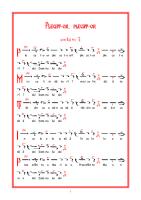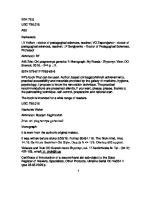157 DiabetesManagement or Cure PDF [PDF]
B io Factsheet www.curriculum-press.co.uk Number 157 Diabetes - Management or Cure? 1. Managing diabetes Diabetics ne
33 0 1MB
Papiere empfehlen
![157 DiabetesManagement or Cure PDF [PDF]](https://vdoc.tips/img/200x200/157-diabetesmanagement-or-cure-pdf.jpg)
- Author / Uploaded
- Naresh Mohan
Datei wird geladen, bitte warten...
Zitiervorschau
B io Factsheet
www.curriculum-press.co.uk
Number 157
Diabetes - Management or Cure? 1. Managing diabetes Diabetics need to know the concentration of glucose in their blood. This has been made much easier by the introduction of reliable, accurate, and “user-friendly” self-glucose monitoring devices.
This Factsheet: • Summarises how glucose concentration are maintained within narrow limits in the body. • Outlines the causes of diabetes. • Summarises how diabetes is being managed and the latest research to find a cure. • Describes the type of exam questions that have been set recently on this topic.
Designs that utilize an enzyme electrode (such as glucose oxidase) and either a hydrogen peroxide or an oxygen detection system appear to be the most successful to date. These electrodes can be placed subcutaneously or intravenously.
Normally, the level of glucose in the blood is controlled by negative feedback (Fig 1).
One new sensor uses polymer spheres within a hydrogel that swells and shrinks reversibly and changes colour in the presence of glucose. The hydrogel contains a glucose-recognition group.
If blood glucose concentration increases, insulin is released from the pancreas and this targets the liver and muscles so that glucose levels fall again. If blood glucose concentration falls then the pancreas releases glucagon and this leads to glucose levels rising again.
As glucose binds to this group the hydrogel expands causing an increase in the spacing between the spheres. This causes a shift in the diffracted light to longer wavelengths which can be converted to an electrical signal.
Diabetes is a condition in which the concentration of glucose in the blood increases because the body cannot control it properly. There are two types:
This can be calibrated to provide a glucose reading.
Type 1: the body cannot make insulin. This is because cells of the body’s immune system release agents including cytokines which kill insulin-producing β-cells. The insulin then has to be injected.
Exam Hint: Refer to blood glucose concentration rather than to blood glucose level. The blood volume is constantly changing but for osmotic reasons blood concentration must be controlled.
Type 2: the body cannot make enough insulin or the insulin it produces does not work properly because other hormones interfere with its actions.
Fig 1. Glucose negative feedback control Insulin stimulates the conversion of glucose to glycogen which is stored in the liver and muscle so blood glucose concentration falls.
Blood Glucose concentration rises. Sensed by receptors on β cells. β cells secrete insulin. Insulin
Islets of Langerhans made of α and β cells
Liver
receptors on β cells no longer stimulated
Muscle
Glucogon stimulates the release of glucose from glycogen so blood glucose concentration falls.
Pancreas
Glucagon
Liver
Blood Glucose concentration falls Sensed by receptors on the α cells α cells secrete glucagon Muscle
1
receptors on α cells no longer stimulated
Bio Factsheet
157 Diabetes - Management or Cure?
www.curriculum-press.co.uk
Curing diabetes
Exam Questions
Recently, scientists have announced that there may soon be a cure for Type 1 diabetes. Several different techniques have shown promise:
Glucose regulation is on every A level specification. Because it involves pulling together several areas of Biology – cells, enzymes, hormones, metabolism, homeostasis, disease and technology, it is a perfect synoptic topic.
1. Transplants Firstly, mice were treated with a chemical to induce Type-1 diabetes. Healthy islet cells were then transplanted into the mice. The cells successfully produced insulin, thus curing their diabetes. In order for this to happen, the normal immune system of the mice had to be inhibited by immumosuppressive drugs. Otherwise, the immune system would have recognised the transplanted cells as foreign and destroyed them.
Fortunately, recent questions have been pretty straightforward! In terms of managing diabetes, questions about simple plastic biosensors are quite common (Fig 3).
Fig 3. Testing for glucose in urine
Now, islet cell transplants into humans appear to have worked. A man who had required daily injections of insulin for the last 28 years received infusions of islet-cells from several donors. The cells were infused through the portal vein into the patient’s liver, where they began to grow. The islet cells have survived and have begun to release insulin (Fig 2).
plastic strip
plastic strip with blue band (containing enzymes and dye)
urine sample
Fig 2. Islet cell transplantation Pancreas
blue band changes colour if glucose is present in the urine
On the first strip label the enzymes glucose oxidase and peroxidase and tell them it’s a blue dye and that it turns brown. This plastic strip is used to decide whether glucose is in a person’s urine. The chemistry is simple: Portal vein 1. glucose + oxygen + water .
Liver Thus the liver is acting as a back-up pancreas. However, there are still problems: • there is simply not enough donor tissue to go around • In previous attempts to do this the immunosuppressive drugs increased the risk of infection and cancer and other side-effects including higher cholesterol levels and mouth ulcers. • This is an example of a xenotransplant –the surgical transfer of cells, tissues or organs from one species to another. It may be unethical and there is the theoretical risk that viruses will be transferred from the animal donor to humans.
2. blue dye +
hydrogen peroxide
glucose oxidase
peroxidase
gluconic hydrogen + acid peroxde brown dye + water
the oxygen generated in this reaction binds to the blue dye changing it brown Typical Questions: 1. Name the two enzymes 2. Explain why the strip only detects glucose 3. Explain why two enzymes are needed 4. Outline the advantages of having the enzymes on a plastic strip Answers: 1. glucose oxidase and peroxidase. 2. The active site of the enzyme glucose oxidase is a complementary shape to glucose so only glucose can fit in. The enzyme and the glucose form an enzyme-substrate complex. 3. The glucose oxidase is detecting the glucose but the first reaction is invisible –there is no colour change. We need the second reaction –and hence the peroxidase –to get a colour change in the dye. Amended extract from recent Chief Examiner’s Report “ some candidates mistakenly thought glucose oxidase detected glycogen………..some thought peroxidase reacted with glucose or glucose oxidase. 4. The test can be done anywhere –if the enzymes were in solution you would need bottles and a lab. It can also be done on finger-prick blood. It’s very easy –nonscientists can do the test. It’s portable/quick/convenient. The sample of urine can be used again. Gives semi-quantitative results.
2. Bio-engineered cells A different approach involves trying to stimulate normal cells to produce insulin. A promoter oncogene is transplanted into fibroblasts - cells that produce connective tissues in the skin, tendons, and blood vessels. Early attempts with oncogenes worked too well – the mass of insulin-producing cells developed into tumours and the animals used suffered severe hypoglycemia (low blood glucose). Now, once enough islets of cells have formed a protein is injected into the animal that inhibits the oncogene. An advantage of this approach is that a person would receive fibroblasts from his/her own body, so that immuno-suppressant drugs would not be necessary. The next step is to replicate the experiment in larger animals, and then to try humans. Stem cells –unspecialised cells that can develop into any other type of cell – are also being investigated. Stem cells from unwanted embryos produced from IVF treatment have the greatest potential to develop into whatever cell type required –but again, there are obvious ethical implications.
Curing diabetes Exam Questions and specifications lag behind research so there is no danger that you will be expected to know lots of details about the new research. However, you could well be given a brief account of any of this research and then asked to explain or comment on it. Whilst the details of stem cell research, transplants and vaccines are not on the specifications, the underlying principles most definitely are.
2. Vaccines Again, mice were treated with a chemical to induce Type-1 diabetes. They then fed half the mice with an oral vaccine – a protein called ISO-1. The mice without the vaccine developed Type-1 diabetes. None of the vaccinated mice did so.
2









